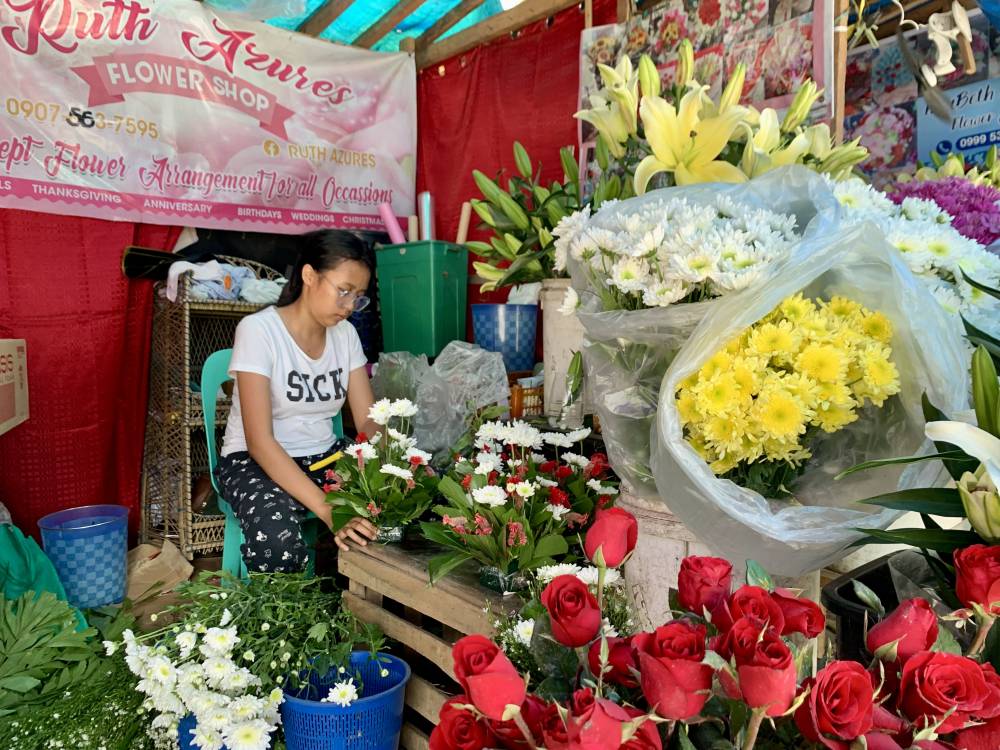‘Leon’ dampens flower sales in Baguio

BAGUIO CITY—The sales of cut flowers like roses, anthuriums and chrysanthemums had been slow in the summer capital as of Wednesday despite having enough supply in time for “undas” – the All Saints Day and All Souls commemoration, partly due to the unpredictable weather caused by Super Typhoon “Leon” (international name: Kong-rey).
However, Albay province, which was battered last week by Severe Tropical Storm “Kristine” (international trami), was in short supply of cut flowers as vendors did not receive the blooms they usually get from Baguio because of the flooded highway in Camarines Sur and the locally-grown one were destroyed by floods, causing a sharp rise in prices.
With a rainy weekend forecast for “undas,” locals and tourists were apparently hesitant to visit temporary flower stalls set up at Malcolm Square in the city’s downtown area.
A few buyers, mostly students heading home for the holiday break, picked up bundles of white carnations for P100 and intricately arranged flower baskets featuring red anthuriums for P500.
Despite the monsoon rains and the recent exit of “Kristine,” flower supplies remain steady, said lawyer Jennilyn Dawayan, director of the Department of Agriculture in the Cordillera.
Mountain farms in Benguet—known for its cool climate conducive to both vegetable and flower cultivation—have continued to produce large quantities of cut flowers.
Early harvests
As of September, flower-producing towns in Benguet, including Atok, Buguias, and Kibungan, have harvested over 5.093 million dozens of flowers, Dawayan reported on Wednesday.
Benguet, already a major source of salad vegetables, also produces an average of 30 million metric tons of fresh flowers annually, with peak demand periods around undas, the December holidays, and Valentine’s Day.
In September alone, Benguet’s towns of La Trinidad, Tuba and Tublay produced 610,049 dozen roses, with La Trinidad leading with 493,762 dozen.
These municipalities, along with others like Bokod, Buguias, and Itogon, also supplied markets with 91,368 dozens of gladiolas, 37,956 dozens of white calla lilies, and 3.455 million dozens of chrysanthemums, most of which were transported to Dangwa flower market in Manila.
Benguet’s flower farms also cultivate a wide range of blooms, including anthuriums, baby’s breath, carnations, asters and sunflowers.
Spared by storm
Dawayan noted the flower gardens were largely spared by Kristine. But the storm affected 303.49 hectares of farmland, including 228.8 ha of rice fields and 74.59 ha of high-value crops, amounting to a P19.8 million loss.
Prior to Kristine’s arrival, farmers managed to harvest 28,049 metric tons of rice.
But in Albay’s Daraga town, Wenny Mantes, 54, who typically harvests 500 kilos of baby’s breath each October, lost about P20,000 when portions of her farm in the town’s Barangay Matnog were flooded on Oct. 21.
“Some of the flowers wilted after being soaked in floodwaters that flowed through the river canal,” Mantes, a florist of 30 years who also supplies flowers to vendors at the Legazpi City public market, told the Inquirer on Wednesday.
Limited supplies
Mantes said she has raised the price of her flower arrangements from P250 to P350 due to limited supplies.
Raquel Loreno, 41, noted they only received bulk supplies on Tuesday, as most deliveries from Baguio City were delayed by flooding along highways in Camarines Sur.
She said only two of the four boxes of Malaysian Mums she ordered have arrived, at a cost of P500 per bundle, up from the usual P450.
Flooding along Maharlika Highway in the towns of San Fernando and Milaor in Camarines Sur prevented buses, heavy vehicles, and trucks carrying essentials from traveling until traffic eased on Oct. 25.
Light vehicles and buses from Albay and Sorsogon were allowed passage on Tuesday as water levels subsided and traffic flow returned to normal.
Evacuations
The Office of Civil Defense (OCD) Bicol reported that 113 bridges and roads were impassable due to flood damage, while another 32 were accessible only to light vehicles. At least 471 villages in Camarines Sur and Libon town, Albay, remained flooded.
As of Wednesday, at least 40,249 families, or 161,768 individuals, remained in evacuation centers in Albay, Camarines Sur, and parts of Camarines Norte.
Over 102,717 people are temporarily staying in private homes and other facilities, according to OCD Bicol spokesperson Gremil Alexis Naz.
The Bicol police have reported 55 deaths, 21 injuries, and five people still missing due to flooding, landslides, and related incidents across the region.

















